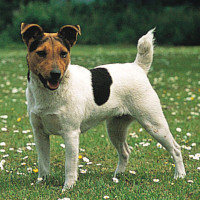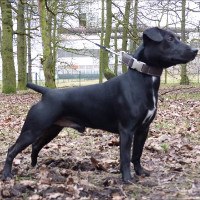Appearance of the Patterjack
|
| The Patterjack is a handsome, small but muscular and stocky dog, around 35.5 centimeters tall, with a short, dense coat and alert posture and expression. The top of the head is only slightly rounded and wedge-shaped, with the ears set high but folded back to almost touch the tip of the eye. Dark or amber eyes don't miss a turn, and the muzzle is long with teeth that meet in a scissor-like pattern. The nose is generally black, but can be brown in liver-colored dogs. A sturdy body on short, strong legs, a high tail and deep chest give this dog a look more powerful than its size. The coat can be a single shade, or a combination of two colors or patches. The alert appearance and active nature demonstrate the true character of the Terrier brand. |
Temperament of the Patterjack
|
| The Patterjack dog could best be described as robust, cheerful, full of energy and needing to do something... anything. They're not the dog for small apartments or houses, as they need a yard to explore or, ideally, the countryside. With a strong hunting instinct, they tend to chase small, fast-moving animals, including cats. This helps if your dog has been raised with a cat, but it doesn't mean he won't chase the neighbor's cat. A typical terrier, they can be overconfident and won't even back down from larger dogs. Walk your dog on a leash to control his natural hunting instinct. This beautiful dog requires strong leadership. Being lenient with this dog won't do him any favors; he needs strong, consistent leadership to stay out of trouble. These are dogs that need jobs. They need to be challenged, like agility work, farm chores or long walks in the countryside to wear them out. As a family dog, they get on well with children. If they've been raised with children, they'll be affectionate and caring. Teach children to respect the dog and not to pull its tail, prick its ears or mess up its food, as this dog may not have the patience to put up with rough treatment. Best described as a true working dog, but loyal, affectionate and handsome, the Patterjack needs a firm, confident hand to bring out the best in him. |
Needs and activities of the Patterjack
|
| Patterjacks are active dogs that come from a working environment. They need at least one long walk a day, two would be ideal. Challenge their minds by involving agility work or set tasks for them to solve to keep these busy minds occupied. They can be over-confident or stubborn when trying to train. These dogs are not for the inexperienced owner, as they can take over and become aggressive and willful if you're not careful. The Patterjack dog needs an active family, they don't just want to sit and snuggle, they want to do things. Not suitable for an apartment, as they are too active and can be quite vocal. They are suited to most climates and like a country setting with lots of work to do. |
Maintenance of the Patterjack
|
| Patterjacks are relatively easy to care for. Their short, thick coat requires brushing every few days to keep it smooth, with occasional combing to get rid of loose hair. These dogs may need more baths than some other companion dogs, due to their active nature and tendency to dig. Don't overdo it, as this could strip the coat of its natural oil, reducing the effectiveness of this weather-resistant coat. While brushing, check for cuts or sores on their body and treat them if necessary. Also check their feet for injuries and trim nails if necessary. The ears are another area that can accumulate dirt and oil, so gently wipe the inner ear with a soft, damp cloth, drying it carefully once you've finished. Twice a week or more, brush your dog's teeth to ensure soft breath. |









 English (United Kingdom)
English (United Kingdom)